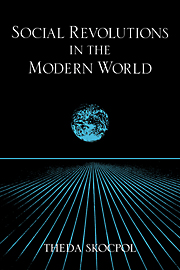Book contents
- Frontmatter
- Contents
- Acknowledgments
- INTRODUCTION
- I DOING MACROSCOPIC SOCIAL SCIENCE
- II MAKING SENSE OF THE GREAT REVOLUTIONS
- III A DIALOGUE ABOUT CULTURE AND IDEOLOGY IN REVOLUTIONS
- IV FROM CLASSICAL TO CONTEMPORARY SOCIAL REVOLUTIONS
- CONCLUSION
- Reflections on recent scholarship about social revolutions and how to study them
- Index
Reflections on recent scholarship about social revolutions and how to study them
Published online by Cambridge University Press: 05 June 2012
- Frontmatter
- Contents
- Acknowledgments
- INTRODUCTION
- I DOING MACROSCOPIC SOCIAL SCIENCE
- II MAKING SENSE OF THE GREAT REVOLUTIONS
- III A DIALOGUE ABOUT CULTURE AND IDEOLOGY IN REVOLUTIONS
- IV FROM CLASSICAL TO CONTEMPORARY SOCIAL REVOLUTIONS
- CONCLUSION
- Reflections on recent scholarship about social revolutions and how to study them
- Index
Summary
Reflections on recent scholarship about social revolutions and how to study them
Comparative and historical scholarship about social revolutions has proliferated in recent years. This has happened, of course, primarily because events in the world have riveted the attention of scholars by throwing up new puzzles to be addressed. The Vietnamese Revolution dramatized issues of peasant mobilization by guerrillas for prolonged nationalist resistance against foreign powers. The Nicaraguan Revolution of 1979 and the agonies of El Salvador throughout the 1980s raised anew questions about the variable fortunes of repressive regimes and armed revolutionaries in Central America and beyond. The overthrow of the Shah of Iran in 1979 flew in the face of all previous theories of revolution and modernization (Keddie 1992). Urban demonstrators, rather than peasant revolts or a protracted guerrilla war, brought about the demise of the Pahlavi regime. And it was soon replaced, not by Western-style liberalism or Sovietstyle communism, but by a dictatorship of militant Shi'a clerics determined to assert Islamic virtue in the face of “imperialist” influences.
By the end of the 1980s, moreover, previous patterns of revolution were in some ways turned on their heads, as the communist regimes of Eastern Europe met their sudden demise. Perhaps these revolutions would open doors to democracy, rather than leading toward new forms of political tyranny, as most revolutions had done in the past. This same possibility was also raised by the evolution of the Nicaraguan Revolution into a kind of (uneasy) constitutional political pluralism (see the discussion in Foran and Goodwin 1993).
- Type
- Chapter
- Information
- Social Revolutions in the Modern World , pp. 301 - 344Publisher: Cambridge University PressPrint publication year: 1994
- 8
- Cited by

